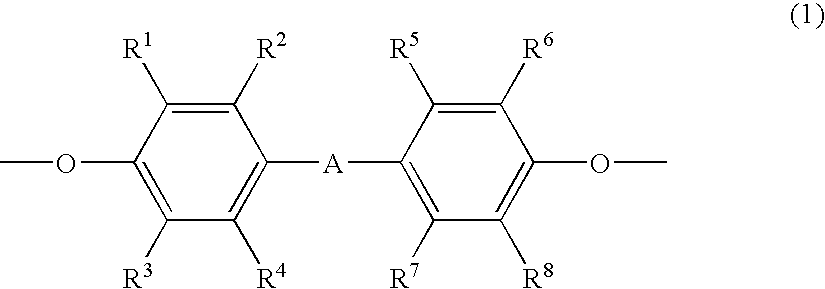Polyester resin composition and process for the preparation thereof
- Summary
- Abstract
- Description
- Claims
- Application Information
AI Technical Summary
Benefits of technology
Problems solved by technology
Method used
Image
Examples
production example 1
[0129]Deionized water was blended with the layered material. Then, the polyether compound was added and stirring was continued for 15 to 30 minutes. The mixture was then dried to a powder form. The layered materials (A-1 to A-6 and B-1 to B-3) were thus obtained. The weight proportions of the raw materials used in this production example are shown in Table 2 (in parts by weight).
[0130]
TABLE 2A-1A-2A-3A-4A-5A-6B-1B-2B-3Deionized100100100100100100100100100waterME1008888888Kunipia F55MM5005106ADE4005NC35PDT8005PEG40056PEG4000S5
production example 2
[0131]A reactor was charged with dimethyl terephthalate (DMT), 76 parts by weight, per 100 parts by weight of DMT, of propylene glycol, 0.003 part by weight of a hindered phenol stabilizer (Asahi Denka's Adekastab A060; hereinafter referred to as A060) and 0.00025 part by weight of Ti(OBu)4 and the transesterification reaction was allowed to proceed between DMT and propylene glycol at a reaction temperature of about 150 to 200° C. with stirring. Thereafter, 0.00025 part by weight of Sb203 was added and the polycondensation was carried out in the molten state at a reaction temperature of 270 to 280° C. under reduced pressure (0.8 to 5.0 torr (0.107 to 0.665 MPa)) to give polypropylene terephthalate (PPT).
examples 1 to 7
[0132]Polyester resin compositions were prepared by melt-kneading PET, the layered material (A-1 to A-6) obtained in Production Example 1 and A060 in the weight proportions shown in Table 3 in a twin-screw extruder (Japan Steel Works' model TEX44) and evaluated. The results are shown in Table 3.
[0133]
TABLE 3Examples1234567PET (wt parts)100100100100100100100A-1 (wt parts)2050A-2 (wt parts)30A-3 (wt parts)20A-4 (wt parts)20A-5 (wt parts)20A-6 (wt parts)30Proportion (%) of particles58456550422251with [D]≦ 3000 ÅMean [D] (Å)2380326020502970352048302940[N] (particles / wt % · 100 μ2)50465746423147Mean aspect ratio57376242361544Mean layer thickness (Å)280360230320380470310Maximum layer thickness (Å)1280149011001560168019601550Ash content (wt %)10.120.310.110.210.210.310.6Flexural modulus (MPa)4990645051004850478045704840Flexural strength (MPa)105112104104102100103Flexural strength after10010395999592905 minutes of retention (MPa)Warpage (mm)3.52.73.43.64.04.53.8Gloss (%)82848382807881
PUM
| Property | Measurement | Unit |
|---|---|---|
| Fraction | aaaaa | aaaaa |
| Mass | aaaaa | aaaaa |
| Area | aaaaa | aaaaa |
Abstract
Description
Claims
Application Information
 Login to View More
Login to View More - R&D
- Intellectual Property
- Life Sciences
- Materials
- Tech Scout
- Unparalleled Data Quality
- Higher Quality Content
- 60% Fewer Hallucinations
Browse by: Latest US Patents, China's latest patents, Technical Efficacy Thesaurus, Application Domain, Technology Topic, Popular Technical Reports.
© 2025 PatSnap. All rights reserved.Legal|Privacy policy|Modern Slavery Act Transparency Statement|Sitemap|About US| Contact US: help@patsnap.com



